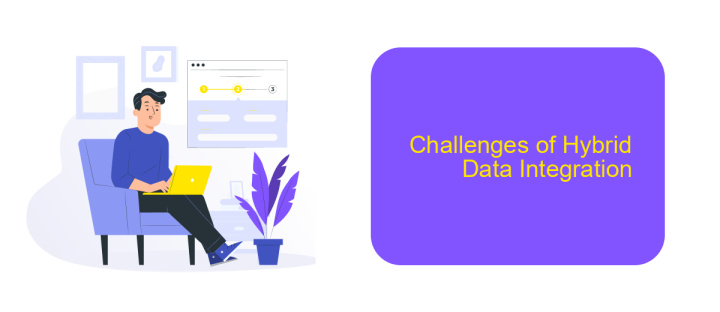Hybrid Data Integration
Hybrid data integration is revolutionizing the way businesses handle diverse data sources, combining on-premises systems with cloud-based solutions. This approach enables seamless data flow, enhancing operational efficiency and decision-making. By leveraging hybrid integration, organizations can achieve greater flexibility, scalability, and real-time insights, ultimately driving innovation and competitive advantage in today's data-driven world.
Hybrid Data Integration
Hybrid Data Integration is a modern approach that combines both on-premises and cloud-based data integration techniques to provide a seamless and efficient data management solution. This method allows businesses to leverage the advantages of both environments, ensuring flexibility, scalability, and cost-effectiveness.
- Integration of on-premises and cloud data sources
- Real-time data processing and synchronization
- Enhanced data security and compliance
- Scalable and flexible architecture
- Cost-effective data management solutions
Services like ApiX-Drive facilitate Hybrid Data Integration by offering tools to automate and streamline the integration process. ApiX-Drive enables businesses to connect various data sources, both on-premises and cloud-based, without the need for extensive coding or technical expertise. This ensures that data flows smoothly and securely across different platforms, enhancing overall operational efficiency.
Introduction

Hybrid Data Integration represents a strategic approach to managing and utilizing data from various sources, both on-premises and in the cloud. This method allows organizations to combine traditional data integration techniques with modern cloud-based solutions, ensuring seamless data flow and improved operational efficiency. By leveraging hybrid integration, businesses can maintain control over their data while taking advantage of the scalability and flexibility offered by cloud services.
One of the key aspects of hybrid data integration is the ability to connect disparate systems and applications effortlessly. Tools like ApiX-Drive facilitate this process by providing a user-friendly platform for setting up integrations without the need for extensive coding knowledge. With ApiX-Drive, companies can automate data transfers, synchronize information across multiple platforms, and streamline their workflows, ultimately driving better decision-making and enhancing overall productivity.
Benefits of Hybrid Data Integration

Hybrid Data Integration offers a multitude of benefits for businesses aiming to streamline their data management processes. By combining on-premises and cloud-based systems, organizations can enjoy greater flexibility, scalability, and efficiency in handling their data.
- Enhanced Flexibility: Hybrid integration allows businesses to choose the best of both worlds, leveraging the strengths of both on-premises and cloud environments.
- Scalability: As data needs grow, hybrid solutions can easily scale to accommodate increasing volumes without significant infrastructure changes.
- Cost Efficiency: By optimizing resource usage and reducing the need for extensive on-premises hardware, hybrid integration can lead to significant cost savings.
- Improved Data Accessibility: Hybrid integration ensures that data is accessible from various sources, enhancing decision-making and operational efficiency.
- Enhanced Security: Sensitive data can be kept on-premises while leveraging the cloud for less critical information, ensuring a balanced approach to data security.
Services like ApiX-Drive facilitate seamless hybrid data integrations by providing user-friendly tools to connect various systems and automate workflows. This ensures that businesses can quickly adapt to changing data needs and maintain a competitive edge in the market.
Challenges of Hybrid Data Integration

Hybrid data integration presents several challenges that organizations must navigate to ensure seamless data flow across diverse systems. One primary issue is the complexity involved in synchronizing data from various sources, each with its own format, protocol, and data structure. This often requires significant effort in data mapping, transformation, and validation to maintain data consistency and integrity.
Another challenge is ensuring real-time data processing and minimizing latency. As businesses demand faster decision-making capabilities, the need for timely data integration becomes critical. However, achieving low-latency integration across hybrid environments can be technically demanding and resource-intensive.
- Data security and compliance: Protecting sensitive data and adhering to regulatory requirements can be more complex in hybrid environments.
- Scalability: Managing the growing volume and variety of data while ensuring performance can be challenging.
- Interoperability: Ensuring different systems and technologies can communicate effectively requires robust integration solutions.
Tools like ApiX-Drive can help mitigate some of these challenges by providing a platform for automated data integration across various applications and services. ApiX-Drive simplifies the setup process, reduces the need for manual intervention, and helps maintain data consistency and security, making it easier for organizations to manage their hybrid data environments effectively.
Best Practices for Hybrid Data Integration
When implementing hybrid data integration, it's crucial to establish a robust data governance framework. This framework should include clear policies for data access, security, and compliance to ensure that data is consistently managed and protected across both on-premises and cloud environments. Additionally, leveraging automation tools like ApiX-Drive can streamline the integration process, enabling seamless data flow between disparate systems without the need for extensive manual intervention.
Another best practice is to ensure real-time data synchronization to maintain data accuracy and consistency. Utilizing services such as ApiX-Drive can facilitate real-time data updates, reducing latency and improving decision-making processes. Furthermore, it's important to conduct regular audits and performance monitoring to identify and resolve any integration issues promptly. By following these practices, organizations can achieve a more efficient and reliable hybrid data integration strategy.
FAQ
What is Hybrid Data Integration?
Why is Hybrid Data Integration important?
What are the challenges associated with Hybrid Data Integration?
How can businesses simplify the process of Hybrid Data Integration?
What are the best practices for implementing Hybrid Data Integration?
Time is the most valuable resource for business today. Almost half of it is wasted on routine tasks. Your employees are constantly forced to perform monotonous tasks that are difficult to classify as important and specialized. You can leave everything as it is by hiring additional employees, or you can automate most of the business processes using the ApiX-Drive online connector to get rid of unnecessary time and money expenses once and for all. The choice is yours!

